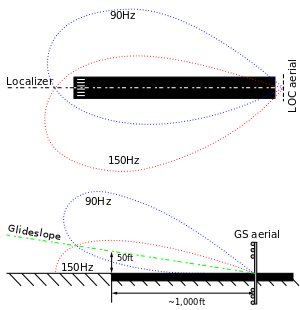AN/CRN-2
The radio set AN/CRN-2 was an air transportable glide path transmitter used by the Army Air Force during and after World War II, the set was standardized on 5 February 1944. and was an upgrade of SCR-592.
Use
Signals from the transmitter are received by the pilot of the aircraft, over the AN/ARN-5 receiving equipment. which provides visual indication of the proper course of descent in the vertical plane during instrument landing operation. At an altitude of 3,000 feet it provides a straight-line glide path course with good definition from a minimum distance of 15 miles from the point of landing contact with the ground. The angle indicated between the horizontal and the glide path is readily adjustable between 2 and 5 degrees.
- The trailer is located 750 feet from the approach end of the runway, and 400 feet to one side, or the other, of the runway centerline.

Statistics
The equipment operates in the frequency range of 329 to 335 Mc. power output is 25 Watts of CW power. the signal is a straight line glide path-double beam MCW Modulated continuous wave system. the range is 15 miles at 3,000 feet.
Components
The transmitting components were mounted on an air transportable trailer (the V-1), power is provided by a PE-120 Generator (115 volts) and PP-29 Rectifier. Total weight is 1800 Lbs.
- An SCR-610 is provided for ground communications
Aircraft component
The AN/ARN-5 consists of antenna system
- AS-27A (combination) and or antenna system
- AS-61. (glide path only) and radio receiver R-89 or R-57.
See also
References
- TM 11-227 Signal Communication Directory. dated 10 April 1944
- TM 11-487 Electrical Communication systems Equipment. dated 2 October 1944
- Graphic Survey of Radio and Radar Equipment Used by the Army Airforce. section 3 Radio Navigation Equipment Dated May 1945
Further reading
- Erik M. Conway (2006). Blind Landings: Low-Visibility Operations in American Aviation, 1918–1958. JHU Press. p. 108. ISBN 978-0-8018-8449-8.